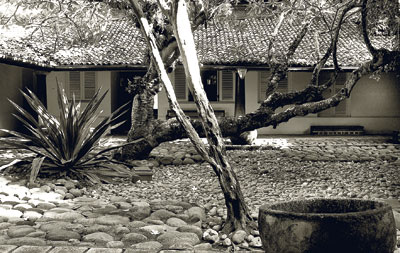It was a house that many recognized as marking a turning point in the career of Sri Lankas most famed architect Geoffrey Bawa. Thus, the news that No. 5, Alfred Place, built by Bawa in the early 1960s for batik artist and designer Ena de Silva was to be sold to a leading private hospital had most heritage lovers in shock.
Now comes the welcome suggestion to have the Ena de Silva house disassembled and rebuilt at the Moratuwa University where it could serve as a design museum.
“The Ena de Silva house in many ways saw the beginning of the Sri Lankan identity in architecture post-independence,” says Architect Milroy Perera, likening the movement by Bawa and his associates Barbara Sansoni, Laki Senanayake, Ena herself and others to the signal contribution made to art by the 43 Group. “Bawa created something that we could call our own, drawing from our own traditions whilst incorporating modern elements. Losing it would be an enormous loss to our heritage.”
 |
| A view of the house. Pic courtesy Dominic Sansoni/ Three Blind Men |
Mr. Perera who built the landmark Kandalama Hotel based on Bawa’s design says a group of architects who were deeply influenced by Bawa – C. Anjalendran, Channa Daswatte, Amila de Mel, and himself – have been working with Prof. David Robson and the Moratuwa University’s Head of Architecture Prof. Harsha Munasinghe to see if the house could be reassembled at the University.
The author of two books on the great man, Prof. David Robson agrees the move would be the best option given the current urban landscape.
“I love this house, but there’s not much point preserving it where it is. It would be far better dismantled and rebuilt elsewhere. We thought of Lunuganga (Geoffrey Bawa’s country residence) but thought it might spoil the garden there and then Milroy Perera came up with this idea of moving it to the Moratuwa University and having it as a Design Museum.” Even though it has not been in the public eye as such, being a private residence, ever since it was photographed and documented in the Times Annual in 1968, the house has had a huge impact, Prof. Robson feels.
The Moratuwa University authorities would welcome the move, affirms Prof. Munasinghe. “The Ena de Silva house was definitely a milestone in the evolution of a Sri Lankan architectural style,” he says, adding that it was also significant in the use of local materials and local craftsmen.
“The Architecture Faculty of the University which was set up in 1961 has long felt a museum was needed on the campus, not just for this faculty but for others as well. It would serve as a valuable resource for the students and maybe architecture students could be involved in the rebuilding process,” he says. This would involve salvaging doors, windows, pillars, artifacts — whatever could be saved and rebuilding it according to the original plan after meticulous documentation had been done.
The decision to preserve it should not be seen as an emotional one, but rather as an intellectual exercise based on saving what it represents, he says, adding that they would need the support of the public in this exercise.
Ajith Tudawe, Chairman of Ceylon Hospital’s Ltd (Durdans Hospital) which would be taking over the property confirmed that Ena de Silva was in favour of the house, which she herself had played an active role in designing, going to the Moratuwa University. “If it’s going to be preserved it’s a good thing,” Mr. Tudawe told The Sunday Times, while declining to divulge what the land would be used for once it changed hands.
A pioneering design
The de Silva House remains one of Bawa's most potent and beautiful designs. At the time of its conception the urban courtyard house was part of a forgotten tradition found only in the old Dutch and Moor streets of Hultsdorf, Galle and Matara.
Coming at a time of growing urban congestion, this house more than any other, was responsible for changing the perceptions of a generation of architects and ultimately of the entire urban population of Ceylon, writes David Robson in his book “Geoffrey Bawa: The Complete Works” (Thames and Hudson- 2002) |

